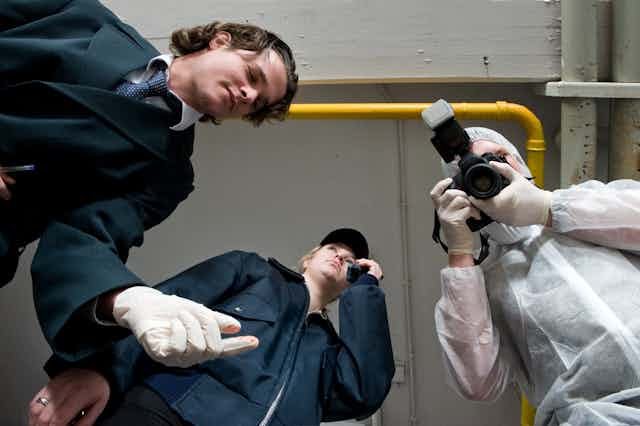Sherlock Holmes could examine a crime scene with nothing but his immense powers of deduction and perhaps a trusty magnifying glass. But real investigators today have much more sophisticated technology at their disposal for carrying out the crucial task of documenting and analysing a crime scene. 3D laser scanning, for example, allows investigators to quickly build a detailed and highly accurate computer model of the scene.
The problem is that this equipment is hugely expensive, often costing tens of thousands of pounds and making it inaccessible to smaller police forces and those facing funding cuts. Handheld scanners are available at a cheaper price, but they are more suited to smaller objects or human profiles, rather than documenting a whole crime scene. However, the task of capturing this detail in 3D could be simplified with technology from an unlikely source – the gaming industry.
Microsoft’s Xbox Kinect is a motion-sensing device designed to let people control and take part in video games using gestures and body movements. The original 360 device sold 24m units in the first two years after it was released in 2010. Microsoft later released a development kit that allowed other programmers to hack into the Kinect’s motion sensing capabilities and use it to control their own software. This opened an amazing new world of possibilities.
Developers used it to control the routine functions of computers but also for more specialist applications such as operating surgical robots in place of systems that would otherwise have cost US$50,000 (£39,000). But perhaps the Kinect’s greatest function is its ability to capture landscapes and objects in three dimensions, with accurate colour mapping and texturing.
Last year, researchers from the University of Vigo, Spain, proposed that the original 360 Kinect might be useful for 3D modelling crime scenes. Their results showed that the 360 Kinect produced too much noise (visual distortion caused by low light) to produce sufficiently accurate measurements unless placed very close to the objects it was scanning. At just three metres away, the Kinect produced errors of between 2-10% in the measurements. While this may seem small, accuracy is everything when it comes to crime scene recording.

The updated Xbox One version of the Kinect features a camera with a pixel depth of 512x424 pixel depth camera (compared to the original’s 320x240 sensor), which means it can capture a wider image with better focus, even in low light situations. The software enhancements and hardware improvements means that it now transmits two gigabits of data per second. This translates to faster capture times when panning and tilting the sensor to record 3D spaces and, most importantly, less noise and measurement inaccuracies.
The Kinect’s improvements were so significant that NASA’s Jet Propulsion Lab signed up for Microsoft’s developer programme in November 2013. The NASA engineers used the new Kinect in combination with an Oculus Rift virtual reality headset to create a system that could allow an astronaut to manipulate a robotic arm just by moving their own arm in the same way. They called it “the most immersive interface” they had ever built.
Building your own 3D scanner
To capture a crime scene in its entirety, the Xbox One Kinect sensor (£89) could be combined with a simple, cheap (£30) computer such as the Arduino Leonardo, a Raspberry Pi, a robotic rotation kit (£60) and tilt kit (£25). This would enable crime scene examiners to automatically scan an entire location in 360 degrees. A laptop with reasonable processing power (at least £999) and a Windows adapter (£38) would also be needed to run the system, but the total cost of the necessary equipment would still come in at less than £1,500. This would be about 43 times less than pre-existing commercial systems available on the market today.
The assembly and operation would be simple and most of the components work straight out of the box without any need for tinkering. Open-source software is freely available and even commercial offerings go for less than £150. Specialised software systems only come bundled with hardware and cost as much as £150,000.
Although more crime scene technologies have come onto the market, their price has not significantly come down, so they are still out of reach for thousands of police forces from across the world. The possibilities of Kinect suggest that maybe it’s time for police forces to take a proactive step in improving their own technologies with a hack of their own. Using a Kinect-based system would be a simple, cost-effective method that could aid investigations and ensure justice in court.

